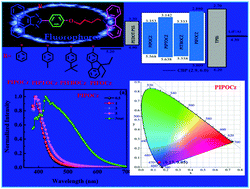Efficient near ultraviolet emissive (CIEy < 0.06) organic light-emitting diodes based on phenanthroimidazole–alkyl spacer–carbazole fluorophores: experimental and theoretical investigation†
Abstract
Efficient near ultraviolet light-emitting materials are of particular importance in organic light emitting devices (OLEDs) because of their potential for application in high-quality flat panel displays and white OLEDs. In the present investigation, a series of efficient near-UV light emitting fluorophores based on the Donor–spacer–Acceptor (D–s–A) geometry were designed and synthesized. In this design strategy, we have linked carbazole groups with phenanthroimidazole units through alkyl spacers (capable of hole and electron transporting in the device) with different functional groups at the N1 position of the imidazole moiety. The structures of all the fluorophores were established using spectroscopic techniques and the synthesized fluorophores show near-UV emission in dichloromethane (DCM) which indicates that the N1 substitutions of the imidazole moiety play an imperative role in the photophysical properties of the synthesized fluorophores. Cyclic voltammetry investigations reveal that the fluorophores have low-lying energy levels of the LUMO ranging from −2.88 eV to −3.35 eV, and of the HOMO ranging from −5.55 eV to −5.80 eV, suggesting that they may possess good charge-transporting properties. A theoretical calculation experiment has been executed to verify the excited state properties of newly synthesized fluorophores and indicates that these twisting D–spacer–A fluorophores exhibit high triplet excited states (ranging from 2.70 to 3.12 eV). The resultant OLED devices based on these fluorophores exhibited near UV-emission with Commission International de L’Eclairage (CIE) color coordinates of y < 0.05 (close to the NTSC standard value) and the maxima of the EL spectra were centered in between 395 and 405 nm at the particle doping concentration. The device using the PIFOCz emitter possesses a favourable maximum external quantum efficiency (EQE) of 3.3%.



 Please wait while we load your content...
Please wait while we load your content...